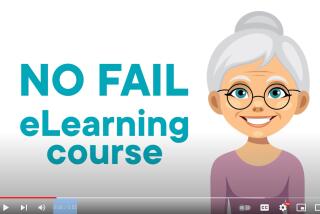New Vision Rules Blurred at DMV
- Share via
It’s supposed to be a simple process.
Your driver’s license expires. You go to the DMV, hand over your license, pay the $12 fee, smile for the camera and in about 30 days you get your new license complete with flashy hologram.
But in dealing with the mammoth bureaucracy of the Department of Motor Vehicles, you first have to get past the clerks, who can hurl drivers to the end of lengthy lines--sometimes because they themselves are not up to date on DMV standards.
For me, the issue lay in the department’s vision guidelines.
I should have realized there would be a problem when the computer “randomly” selected my name to take a written test in order to renew my license.
Before taking the written test, I first had to pass a mandatory eye exam by reading a chart.
I was once again faced with a dilemma: I either had to fudge my way through the test by partially covering my right eye or tell the truth: that I have a lazy left eye (clinically known as amblyopia), in which I have been legally blind since birth.
This condition hasn’t hampered my overall vision. I have 20-15 vision in my right eye and have been driving for 14 years. I have had driver’s licenses in three states.
I decided to take my chances and tell the clerk, Elvira, my story. (Under DMV procedure, employees do not give their last names.)
“Before we start, you should know that I’m legally blind in my left eye,” I told her. “I can see lighted shapes and colors, but I won’t be able to read the chart. My right eye is fine, though, no problems there.”
I smiled, hoping she’d wave this off as a minor technicality, give me the vision test for my right eye and wish me well on the written test. Fat chance.
“You’ll need a doctor’s note saying that your eye is OK,” Elvira told me, handing me a DMV eye exam form for an optometrist to fill out. “It’s the new rules.” According to DMV standards, Elvira said, I can’t see sufficiently to drive.
I returned to the DMV office, two days later, completed DMV eye exam form in hand, stating that my lazy eye condition was stable, my right eye was perfect and I was in prime shape to handle a vehicle.
I got on line for Window S, again, hoping to get Elvira, hand her the form and get on with the process. This time I got Marlene.
Marlene reviewed the form, ignored the optometrist’s nearly illegible information and made me take yet another eye exam.
My left eye failed. My right eye passed. And Marlene wanted an explanation. I recounted my left eye saga, the doctor’s note and my conversation with Elvira, who assured me the doctor’s note would satisfy DMV rules.
Marlene wasn’t satisfied and instead conferred with her co-worker, Laura. After some mumblings they decided I needed to retake my driving test.
“The rules changed in July and the new standards say you have to have at least 20-40 vision in both eyes or else you’ll have to prove to us that you can drive,” Laura said.
Marlene scheduled my test for the day after Christmas.
A driving test?! After 14 years on the road with the same condition that began while I was in the womb?
Au contraire, said Patty Caraska, a program analyst in charge of the department’s vision screening process: Neither a doctor’s note nor a driving test was necessary.
According to new DMV vision screening standards established in February after a two-year study by a panel of employees, optometrists and ophthalmologists, a doctor’s exam is required under certain conditions, such as a person’s deteriorating eyesight in one eye or if they have some eye problems and are getting their license for the first time in California.
“If you’re blind in one eye and your sighted eye is 20-20 then together it’s possible you can see 20-20 and then you’d pass the vision screen standard,” Caraska said.
In August, the vision guidelines were revised again, eliminating the driving test for people with stable forms of amblyopia, myopia (nearsightedness) or hyperopia (farsightedness).
“From February to August, we said if the visual acuity was 20-70 or worse, the driving test was necessary,” Caraska said.
“The guidelines were changed to say if a person is monocular, regardless of the vision problem in the other eye, they only need to have proof of their condition and they don’t need to take the driving test or have a doctor’s note.”
“The person who saw you the second time should never have told you to take the driving test,” she said.
By the time Caraska explained the law, I was already off the hook for the driving test. Marilyn, the driver’s licensing supervisor at the DMV branch in Canoga Park, had double-checked the DMV driver’s license manual and explained to her employees that I was OK to drive.
Laura was incredulous, trying to cite the regulations from the vision chapter of the cumbersome manual doled out to DMV field office staff.
Too bad. I realize the new vision screening guidelines aren’t simple. But they can, however, be found in Chapter 7 of the Driver’s License Manual.
More to Read
Sign up for Essential California
The most important California stories and recommendations in your inbox every morning.
You may occasionally receive promotional content from the Los Angeles Times.









